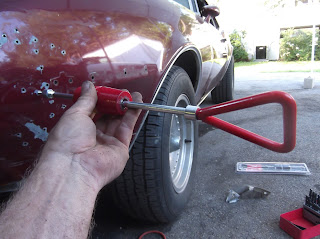Specifically, what did I learn from my ownership of the 58 Biscayne? Maybe some was learned, and some was just confirmation of things I knew, but ignored in the face of buying a car I had really wanted for a long time. My first car was a 64 Biscayne, and my favorite car is a 58 Impala, so I got a 58 Biscayne (58 Impalas were too expensive).
Some of what I learned:
Never buy a car with a cracked windshield. You cant see it in the photo above, but the 58s windshield is cracked. The windshield replacement was like a huge weight hanging over me, since I didn't trust myself to do it, and I knew it would cost around $500 to have it done. It never got done.
Never cut out the rear wheelwells. The rear wheel lip areas in the body of this car were rusted out, and so while repairing them I reshaped them to have more clearance for wider tires. If you look at the photo above, the original rear wheelwell edge would be down to about the top of the rim top edge. I raised them about 5", and I tried to mimic the front wheelwell shape. I think I did a great job. But for some reason, I was never completely happy with this modification.
Never sell an unpainted car. I concentrated on mechanical issues, so I never got new paint on the 58. If I had finished the body and paint, I could have probably made a lot more on the sale of the car. The paint looks good here, but I had to take pics in the rain one morning, so its just wet.
Never buy a car with an unfinished interior. This didnt bother me when I bought the car, since it would be a chance to do the interior a little custom and cool. But this would have to be farmed out to an upholstery shop, and it would likely cost thousands. The dash was all hacked up in the radio area, and I would have to fix that. Just detailling the interior trim parts and installing all of it (it came in a bundle in the trunk) was a daunting task I wasnt looking forward to.
Even things that 'will be easy' will take time, effort, and some money. Detailing the engine bay is an example. Easy. Also way down a long list of things that just never got done. Youre lucky I dont have any pics of the trunk, it was a disaster. Again, a very fixable disaster, given time, but a disaster nonetheless.
In short, I bought a car that needed too much work. It was all work I could have accomplished if I had more time and/or money. I just dont have as much of either as I used to. Just dont get into a project if you dont have the finances and/or time to see it through. I woefully underestimated (WILLFULLY IGNORED would be more correct) my own finances, time, and patience.
If I work a full week, its 55 hours (!) for about 1/4 of what I used to make. Thats on my feet for 10 hours, doing very physical work. I get home from work and Im dead tired. I have a family, and my young daughter has activities I do not want to miss. Plus it stinks waiting months to spend just a hundred dollars for parts; which I then feel bad about since I make so little. I did not take into account how mentally draining these factors would be over time. Instead of realizing how far I had progressed, all I could think about was how far I had to go. It would be years, and thousands of dollars, and I just got fed up.
This is not the first project I have abandoned, but I do feel like I have given up on a big dream of mine, and thats tough. Of course, I have found that part of growing older is realizing and accepting that some of your dreams will not be realized; and thats just the way it is. Like I said, maybe I will own another 58, and maybe not.
So OF COURSE, just a day or so after the 58 left, Im looking at a hot rod message board I frequent, and somebody posts this:
58 Impala, factory Aztec Bronze color, all jacked up, front bumper removed, ridiculously wide mags and tires...the closest I have ever seen to the original 'Devils Haven' from the Wappingers area, the same car that I was just totally captivated with as a young boy (the acutal DH was way more tasteless, but way cooler to me).
Anyway, a bit of a kick in the nuts there. I not finish my 58; it would never be the 'more mature' version of my inspiration that I had planned. Dang, it hurts, but getting into a decent 58 Impala is $20,000 now, bad economy or not. I hope I know what I am doing.




















































